GWAS and WGCNA analysis uncover candidate genes associated with drought in Brassica juncea L
- PMID: 40256595
- PMCID: PMC12007043
- DOI: 10.3389/fpls.2025.1551804
GWAS and WGCNA analysis uncover candidate genes associated with drought in Brassica juncea L
Abstract
Drought poses a major challenge to crop growth and yield, and exploring the drought tolerance of crops is an effective and economical approach to mitigating the effects of drought. To screen drought-tolerant germplasm resources and key functional genes related to drought tolerance in Brassica juncea L.(193 accessions), three treatments were applied at the germination and seedling stages:control(CK), moderate drought stress (M), and severe drought stress (S). Drought tolerance identification, GWAS, and RNA-Seq analysis of these materials under different treatments showed that drought stress significantly reduced the germination rate, aboveground and underground fresh weight at the seedling stage, harvest index at maturity, and expanded the root/shoot ratio. From the 193 materials, 24 drought-tolerant, 139 drought-tolerant medium, and 30 drought-sensitive materials were identified. The 77 SNPs identified by GWAS were associated with the relative germination rate at the germination stage, and the fresh weight of the aboveground and underground parts at the seedling stage, which could be integrated into 27 QTLs. WGCNA identified 15, 0, and 5 modules significantly related to drought tolerance in the aboveground and underground parts at the germination and seedling stages, respectively. By correlating the significant GWAS SNPs with the significant WGCNA modules, a total of 11 genes related to drought tolerance under moderate and severe drought stress were identified. These genes were involved in the regulation of auxin-responsive protein (SAUR), LEA protein, glucosidase, AP2/ERF, WRKY and GATA transcription factors, FLZ zinc finger domain, PRP, and b561 proteins. Among them, the BjuB035910 gene was detected in the underground parts of the seedling and germination stages under moderate drought stress. GWAS and selective sweep analysis jointly identified the 23.955-24.089 Mb region of chromosome B06, where four genes (BjuB022264, BjuB022292, BjuB022282, and BjuB022235) were located, as confirmed by WGCNA analysis. A total of 125 SNPs with high linkage disequilibrium were found in this region, and 12 haplotypes were detected, with Hap1 being present exclusively in drought-tolerant materials and Hap3-Hap12 distributed in drought-sensitive materials. These findings provide new insights into the drought tolerance mechanisms of B. juncea and will contribute to the breeding of drought-tolerant rapeseed varieties.
Keywords: Brassica juncea L.; GWAS; WGCNA; drought; genes; selective sweep analysis.
Copyright © 2025 Zhang, Yuan, Zhang, Luo, Zhao, Zu, Tian, Li, Zhang, He, Gao, Fu, Li and Liu.
Conflict of interest statement
The authors declare that the research was conducted in the absence of any commercial or financial relationships that could be construed as a potential conflict of interest.
Figures






Similar articles
-
GWAS identifies novel loci linked to seedling growth traits in highly diverse barley population under drought stress.Sci Rep. 2025 Mar 24;15(1):10085. doi: 10.1038/s41598-025-94175-y. Sci Rep. 2025. PMID: 40128265 Free PMC article.
-
Genetics of Germination and Seedling Traits under Drought Stress in a MAGIC Population of Maize.Plants (Basel). 2021 Aug 27;10(9):1786. doi: 10.3390/plants10091786. Plants (Basel). 2021. PMID: 34579319 Free PMC article.
-
Transcriptome profile analysis of Indian mustard (Brassica juncea L.) during seed germination reveals the drought stress-induced genes associated with energy, hormone, and phenylpropanoid pathways.Plant Physiol Biochem. 2023 Jul;200:107750. doi: 10.1016/j.plaphy.2023.107750. Epub 2023 May 14. Plant Physiol Biochem. 2023. PMID: 37210860
-
Dissection of quantitative trait nucleotides and candidate genes associated with agronomic and yield-related traits under drought stress in rapeseed varieties: integration of genome-wide association study and transcriptomic analysis.Front Plant Sci. 2024 Mar 19;15:1342359. doi: 10.3389/fpls.2024.1342359. eCollection 2024. Front Plant Sci. 2024. PMID: 38567131 Free PMC article.
-
Recent progress in drought and salt tolerance studies in Brassica crops.Breed Sci. 2014 May;64(1):60-73. doi: 10.1270/jsbbs.64.60. Breed Sci. 2014. PMID: 24987291 Free PMC article. Review.
Cited by
-
Genome-wide association study and transcriptome analysis reveal candidate genes related to drought stress in the germination stage of soybean.Front Plant Sci. 2025 Jul 30;16:1621869. doi: 10.3389/fpls.2025.1621869. eCollection 2025. Front Plant Sci. 2025. PMID: 40810017 Free PMC article.
References
-
- Ashraf M., Shahbaz M., Ali Q. (2013). Drought-induced modulation in growth and mineral nutrients in canola (Brassica napus L.). Pak. J. Bot. 45, 93–98.
-
- Batool M., El-Badri A. M., Wang Z., Mohamed I. A., Yang H., Ai X., et al. . (2022). Rapeseed morpho-physio-biochemical responses to drought stress induced by PEG-6000. Agronomy 12, 579. doi: 10.3390/agronomy12030579 - DOI
-
- Boureima S., Eyletters M., Diouf M., Diop T., Van Damme P. (2011). Sensitivity of seed germination and seedling radicle growth to drought stress in sesame sesamum indicum L. Res. J. Environ. Sci. 5, 557.
LinkOut - more resources
Full Text Sources
Research Materials
Miscellaneous

